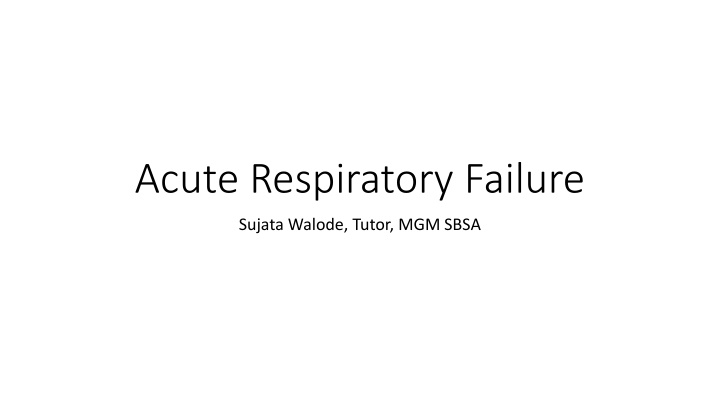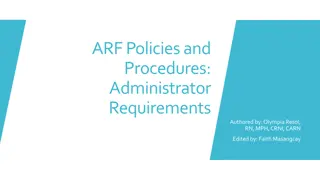
Acute Respiratory Failure: Causes, Symptoms, and Treatment
Learn about acute respiratory failure (ARF), a medical emergency where the respiratory system fails to provide enough oxygen to the body. Explore its etiology, symptoms, common causes, and management options for this life-threatening condition.
Download Presentation

Please find below an Image/Link to download the presentation.
The content on the website is provided AS IS for your information and personal use only. It may not be sold, licensed, or shared on other websites without obtaining consent from the author. If you encounter any issues during the download, it is possible that the publisher has removed the file from their server.
You are allowed to download the files provided on this website for personal or commercial use, subject to the condition that they are used lawfully. All files are the property of their respective owners.
The content on the website is provided AS IS for your information and personal use only. It may not be sold, licensed, or shared on other websites without obtaining consent from the author.
E N D
Presentation Transcript
Acute Respiratory Failure Sujata Walode, Tutor, MGM SBSA
Definition Acute respiratory failure (ARF) is a medical emergency that occurs when the respiratory system fails to provide adequate oxygenation to the body's tissues and/or fails to adequately remove carbon dioxide from the blood. It can be a life-threatening condition and requires immediate medical attention. ARF can result from various underlying causes and can affect people of all ages.
Etiology and Pathophysiology: Etiology and Pathophysiology: There are two main types of acute respiratory failure: Hypoxemic respiratory failure: This occurs when the level of oxygen in the blood is too low (PaO2 < 60 mmHg), and it is often associated with ventilation-perfusion (V/Q) mismatch or shunting. Some common causes of hypoxemic respiratory failure include: Pneumonia Acute respiratory distress syndrome (ARDS) Pulmonary edema (fluid accumulation in the lungs) Pulmonary embolism (blockage of a pulmonary artery) Inhalation injuries Hypercapnic respiratory failure: This occurs when the level of carbon dioxide in the blood is too high (PaCO2 > 50 mmHg). It is usually due to inadequate ventilation, leading to a buildup of carbon dioxide. Causes of hypercapnic respiratory failure include: Chronic obstructive pulmonary disease (COPD) Severe asthma exacerbation Neuromuscular disorders affecting respiratory muscles (e.g., myasthenia gravis, amyotrophic lateral sclerosis)
Symptoms The symptoms of acute respiratory failure may include: Severe shortness of breath or difficulty breathing Rapid breathing (tachypnea) Bluish discoloration of the skin and lips (cyanosis) Confusion or altered mental status Rapid heart rate (tachycardia) Fatigue and weakness Wheezing or crackling sounds in the lungs Decreased level of consciousness or coma (in severe cases)
Causes The causes of acute respiratory failure can vary, but some common factors include: Lung infections such as pneumonia and bronchitis Chronic lung diseases like COPD and emphysema Acute lung injuries, including ARDS Cardiac-related pulmonary edema Pulmonary embolism (blood clot in the lungs) Severe asthma attacks Chest trauma or injuries Drug overdose Neuromuscular diseases affecting respiratory muscles
Treatment and Management: Treatment and Management: The management of acute respiratory failure aims to address the underlying cause, improve oxygenation, and support the respiratory system. The treatment will depend on the specific type and severity of ARF, but some common approaches include: Oxygen therapy: Supplemental oxygen is provided to improve oxygen levels in the blood. Various delivery systems can be used based on the patient's needs. Mechanical ventilation: In severe cases, when a patient cannot breathe adequately on their own, they may require intubation and mechanical ventilation. This helps with both oxygenation and carbon dioxide removal. Medications: Depending on the underlying cause, medications like antibiotics for infections, bronchodilators for asthma or COPD, and diuretics for pulmonary edema may be administered. Treat the underlying cause: Addressing the specific condition responsible for ARF is crucial to improve respiratory function. Positioning: Proper positioning can help optimize lung function, especially in cases of ARDS. Supportive care: This includes measures to maintain blood pressure, fluid balance, and nutrition.
Treatment and Management: Treatment and Management: Chest physiotherapy: Techniques like percussion and postural drainage may aid in clearing airway secretions. Monitoring: Continuous monitoring of vital signs, blood gases, and other relevant parameters is essential to assess the patient's response to treatment. The management of acute respiratory failure is complex and requires a multidisciplinary approach involving critical care physicians, respiratory therapists, nurses, and other healthcare professionals. Timely recognition and prompt intervention are crucial in improving outcomes for patients with acute respiratory failure.










